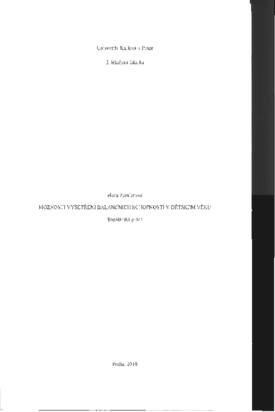Možnosti vyšetření balančních schopností v dětském věku
Oprions of balance examination in children
bachelor thesis (DEFENDED)

View/
Permanent link
http://hdl.handle.net/20.500.11956/24464Identifiers
Study Information System: 86187
CU Caralogue: 990012315030106986
Collections
- Kvalifikační práce [1802]
Author
Advisor
Referee
Smolíková, Libuše
Faculty / Institute
Second Faculty of Medicine
Discipline
Physiotherapy
Department
Department of Rehabilitation and Sports Medicine
Date of defense
20. 5. 2010
Publisher
Univerzita Karlova, 2. lékařská fakultaLanguage
Czech
Grade
Very good
Keywords (Czech)
vyšetření, rovnováha, dětský věkKeywords (English)
examination, balance, childhoodCílem práce bylo shromáždit poznatky o vyšetřovacích polohách, úkonech a testech cílených na rovnovážné funkce. Na začátku práce se hovoří všeobecně o rovnovážných funkcích a o jejich vývoji v rámci dětského věku. Ve speciální části se práce zaměřuje na vyšetřovací metody použitelné v dětském věku. Z klinických vyšetřovacích metod práce pojednává o statických, dynamických i o testovacích bateriích. U statických vyšetření se práce věnuje polohám vycházejícím ze vzpřímeného stoje. Dynamická vyšetření jsou zaměřena zejména na modifikovanou chůzi. Dále se práce zabývá objektivizujícím přístrojovým vyšetřením balančních funkcí. Práce je založena na rešeršním sběru informací. Powered by TCPDF (www.tcpdf.org)
The aim ofthe work was gather to information about investigative positions, operations and tests foeused on the equilibrium funetion. At the beginning the work speaks generally about balanee fubetion and their development in ehildhood. ln a speeial part of my work foeuses on investigative methods to be used in ehildren. From clinieal examination methods work deals with statie, dynamie testing as well as batteries oftests. For statie tests, the work turns on positions from an upright standing pos ition. Dynamie tests are foeused primarily on a modifled walking. Then the paper deals with instrumentation objeetive balanee funetion testing. Finally, this thesis work is based on the retrieval ofdata eolleetion. Powered by TCPDF (www.tcpdf.org)
